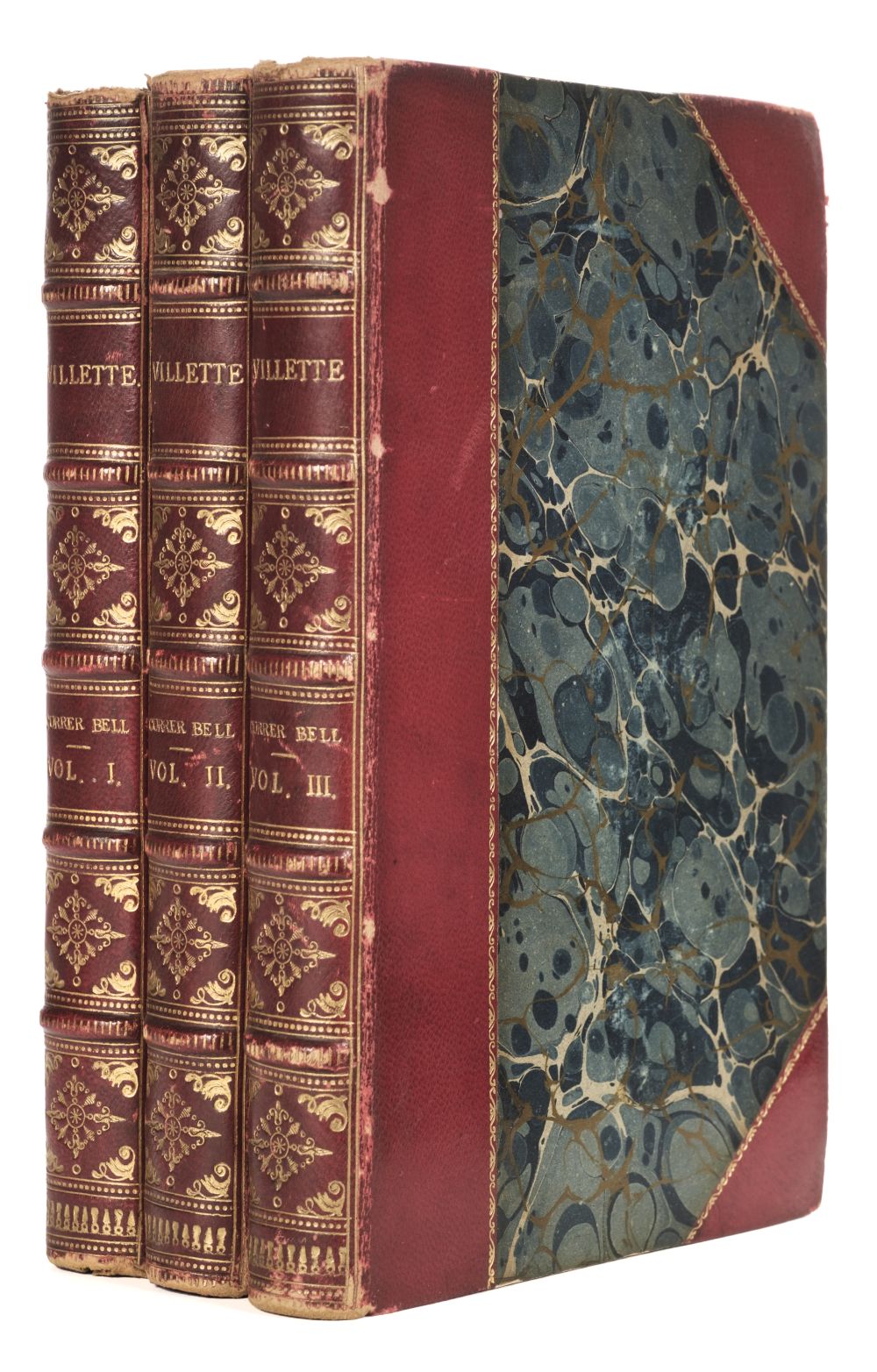Property from the Workman Collection
[Brontë, Charlotte]Villette. By Curer Bell, Author of "Jane Eyre," "Shirley," etc. London: Smith, Elder & Co., 1853
3 vols., 8vo. Title-page to each volume, 12pp. publisher's catalogue dated January 1853 at end of vol. 1; very slight ink stain to first title. Original olive brown blind-stamped cloth, bound by Westley & Co., spines gilt-lettered, yellow endpapers with W. Webster book ticket to each volume; upper paste-down of vol. 1 cracked. Housed in custom green morocco clamshell case. Overall, a fine copy.
First edition, the Stockhausen-Ewing copy.
“Wise people say it is folly to think anybody perfect; and as to likes and dislikes, we should be friendly to all, and worship none.”
One of Brontë's more autobiographical works, the novel follows Lucy Snow as she journeys from from England to Villette, a fictional city based on Brussels. Brontë herself traveled to Brussels in 1842, along with her sister Emily, where they were enrolled in boarding school, but the sisters were forced to return to England early, following the death of their aunt. In 1843, Charlotte returned to Brussels, where she fell in love with the married M. Héger.
Much in the vein of Jane Eyre (1874), Brontë explores themes related to medicine and environmental science in Villette. The novel's opening line, "My godmother lived in a handsome house in the clean and ancient town of Bretton," nods to Brontë's preoccupation with sanitary science. Dr. John Graham Bretton, the novel's handsome young physician, is a direct reference to Dr. Thomas John Graham whose Modern Domestic Medicine was a staple of the Brontë household.
A fine copy of Brontë's third and final novel published before her death.
REFERENCE:Parrish 95; Sadleir 349; Metzdorf 384
PROVENANCE:William E. Stockhausen (his sale, Sotheby's Parke Bernet, 19-20 November 1974, lot 44) — Douglas C. Ewing (his sale, Christie's New York, 7 April 1978, lot 54; booklables to front pastedowns)
Property from the Workman Collection
[Brontë, Charlotte]Villette. By Curer Bell, Author of "Jane Eyre," "Shirley," etc. London: Smith, Elder & Co., 1853
3 vols., 8vo. Title-page to each volume, 12pp. publisher's catalogue dated January 1853 at end of vol. 1; very slight ink stain to first title. Original olive brown blind-stamped cloth, bound by Westley & Co., spines gilt-lettered, yellow endpapers with W. Webster book ticket to each volume; upper paste-down of vol. 1 cracked. Housed in custom green morocco clamshell case. Overall, a fine copy.
First edition, the Stockhausen-Ewing copy.
“Wise people say it is folly to think anybody perfect; and as to likes and dislikes, we should be friendly to all, and worship none.”
One of Brontë's more autobiographical works, the novel follows Lucy Snow as she journeys from from England to Villette, a fictional city based on Brussels. Brontë herself traveled to Brussels in 1842, along with her sister Emily, where they were enrolled in boarding school, but the sisters were forced to return to England early, following the death of their aunt. In 1843, Charlotte returned to Brussels, where she fell in love with the married M. Héger.
Much in the vein of Jane Eyre (1874), Brontë explores themes related to medicine and environmental science in Villette. The novel's opening line, "My godmother lived in a handsome house in the clean and ancient town of Bretton," nods to Brontë's preoccupation with sanitary science. Dr. John Graham Bretton, the novel's handsome young physician, is a direct reference to Dr. Thomas John Graham whose Modern Domestic Medicine was a staple of the Brontë household.
A fine copy of Brontë's third and final novel published before her death.
REFERENCE:Parrish 95; Sadleir 349; Metzdorf 384
PROVENANCE:William E. Stockhausen (his sale, Sotheby's Parke Bernet, 19-20 November 1974, lot 44) — Douglas C. Ewing (his sale, Christie's New York, 7 April 1978, lot 54; booklables to front pastedowns)












.jpg)
Testen Sie LotSearch und seine Premium-Features 7 Tage - ohne Kosten!
Lassen Sie sich automatisch über neue Objekte in kommenden Auktionen benachrichtigen.
Suchauftrag anlegen